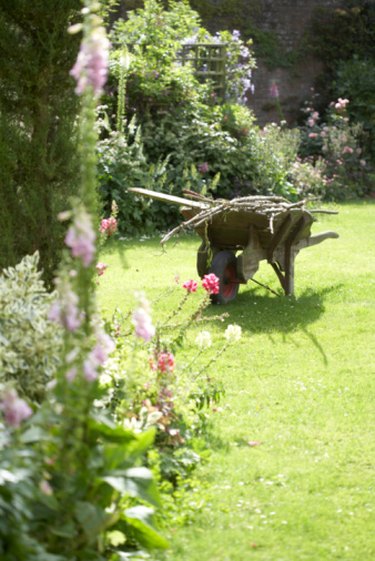Things You'll Need
Bushes
Trees
Shovel
Flowering plants
Shrubs
Containers
Compost
Non-flowering plants
Herbs
Vegetables

A 1/2-acre back yard provides enough space to have a lawn, an area allocated to edibles such as vegetables and herbs, and locations for large trees. It also provides space for an area to entertain guests and a garden shed. Consider for what you want to use the back yard, and then draw a sketch to provide a clear plan of how to use the available space.
Step 1
Frame your landscape with bushes and trees. If your back yard is next to a noisy road, then plant trees that have very thick foliage to reduce the noise. Southern Magnolias reduce noise well, as do evergreens such as juniper and Cyprus trees. You can hide an unsightly fence with a weeping willow tree and screen a driveway with arborvitae or Leyland Cyprus.
Video of the Day
Step 2
Remove all existing trees that are too close to the house, diseased or likely to cause a safety hazard.
Step 3
Plant trees that you want to grow inside the frame of trees and bushes you planted. If your back yard is north of the house, then plant evergreen trees such as cedar to reduce wind during winter. If your back yard is south of the house, plant deciduous trees to provide shade in summer and to let sunshine through in winter to help melt ice on the ground and warm the house. Fruit trees such as apple and plum are deciduous and provide a supply of fruit.
Step 4
Dig borders along the house, and place flowering plants and shrubs in them. Plant tall, structural plants such as jasmine and rose bushes toward the back of the borders and smaller perennials and annuals such as geraniums, daffodils and irises at their front. Plant flowers in clumps to create the most attractive effect. Create flowerbeds in shady areas of your 1/2-acre back yard, and plant shade-loving plants, which include hosta. Put sun-loving plants such as lilies and salvia in sunny areas.
Step 5
Fill containers with compost and a variety of plants, including flowering plants. Herbs such as rosemary, basil and chives work very well in pots, as do small trees such as lemon and orange trees. Bulbs also can be planted in pots for summer flower displays. Containers create a portable garden. The backyard patio or other entertaining area can be decorated with the containers, as can paths and other areas of the back yard you want to highlight. Planting edibles such as vegetables in the containers means your don't need to prepare a separate bed in your back yard for a vegetable garden.
Tip
Allocate an area to vegetables. Prepare raised beds for the best chance of success.
Fruit bushes can provide privacy and food.
Running out of room is possible, especially if a large area is dedicated to lawn. If that occurs, plant vertically with winding clematis, hanging baskets filled with herbs, and sweat peas and beans that climb poles.
Video of the Day
- University of Nebraska-Lincoln Extension: Backyard Farmer
- Virginia Cooperative Extension: Trees for Problem Landscape Sites -- Screening; Bonnie Appleton, et al.; 2009
- Colorado State University Cooperative Extension: Creative Screening with Plants; Kathy Brown; 2010
- "Connecticut College Arboretum Bulletin"; Naturalistic Landscaping; William A. Niering; 1975; 2009
- North Carolina State University: Landscaping the Back Yard for Birds; David Goforth